This issue: Contents
Tuesday, October 6th, 2015
- Editor’s Note
- WCHS News: Boutwell House Barn Sale
- WCHS News: Scandia Living Cemetery Tour – This Weekend!
- What Is This Thing?!
- Old News: A Post Office Heist
- Featured Article: Burying Stillwater’s Dead
Editor’s Note
Happy October everyone!
First off, let me send out a huge thank you to everyone who attended our Fall Membership Meeting a few weeks ago! It’s always such a great experience to get so many supporters of Washington County history all together in one room. I even had a chance to chat with a few folks who said they read this humble e-newsletter!
Onto the issue!
In today’s News Section you’ll read about all our upcoming events; including a fundraiser barn sale at the historic Boutwell House, a “living cemetery” tour, and our ever popular Paranormal Investigations program.
I dove into our artifact collection to select another item for this week’s “What Is This Thing?!”
We’ll read about a lackluster historic robbery that probably won’t ever be adapted into a Hollywood blockbuster.
And finally, you may have heard recently that Rev. Boutwell’s headstone was vandalized. This deeply disrespectful act left many here at the historical society scratching our heads and asking, “why?” Thankfully, the monument was repaired a few days later.
This incident serves as a reminder that even though these people were buried a hundred years ago and their children and children’s children are all long gone – today, we still have a responsibility to protect their final resting places.
In today’s Featured Article, we’ll take a look at where early Stillwater pioneers laid their departed to rest.
Want to learn more about the history of Washington County? “Like” WCHS on Facebook and follow us on Twitter!
Sean Pallas
Historical Messenger editor and Warden’s House Site Manager
spallas.wchs@gmail.com
WCHS News
Boutwell Barn Sale
 The Washington County Historical Society will have a fundraising sale at the historic Boutwell House at 12588 Boutwell Road North in Stillwater this Thursday, October 8th and Friday, October 9th from 9am to 3pm each day.
The Washington County Historical Society will have a fundraising sale at the historic Boutwell House at 12588 Boutwell Road North in Stillwater this Thursday, October 8th and Friday, October 9th from 9am to 3pm each day.
The Boutwell House, owned by the Rev. Wm. T. Boutwell, was recently purchased by the Historical Society to restore and preserve one of the most historic sites in Washington County. Rev. Boutwell helped to name the source of the Mississippi River, was the first Chaplain of the Minnesota Territorial Senate and helped to organize the First Presbyterian Church in Stillwater, among many other historic events that spanned his lifetime.
The sale will help to benefit the preservation of the historic site.
Items can be donated to the sale by contacting the Washington County Historical Society or Megan Sherrard-Stuart at 651-470-6320 or by dropping them off at the Boutwell House tonight, Tuesday, October 6th from 5pm to 7pm.
Other times can be arranged.
More: Events
WCHS News
Scandia Living Cemetery Tour – This Weekend!
As October and Halloween approaches, we all seem to have goblins, ghouls, and (of course) ghosts on the mind!
Well here at WCHS we’re certainly are keeping in spirit with this spooky autumn mood with two exciting events.
First, this Sunday, October 11th, we’ll be giving you a chance to chat with the ‘ghosts’ of Scandia’s history during a Living Cemetery Tour of the Elim Cemetery from 11:00 AM – 2:00 PM.
Guests will be guided through the cemetery, stopping to meet actors portraying various figures of the area’s history – all whom are buried at this very cemetery. You’ll meet a former reverend of the church, a victim of the 1931 meningitis outbreak, a Civil War soldier, and more on this interesting and unique way to explore local history.
This free and open to the public event is made possible through a joint partnership between the Gammelgården Museum, the Elim Lutheran Church of Scandia, and the Washington County Historical Society.
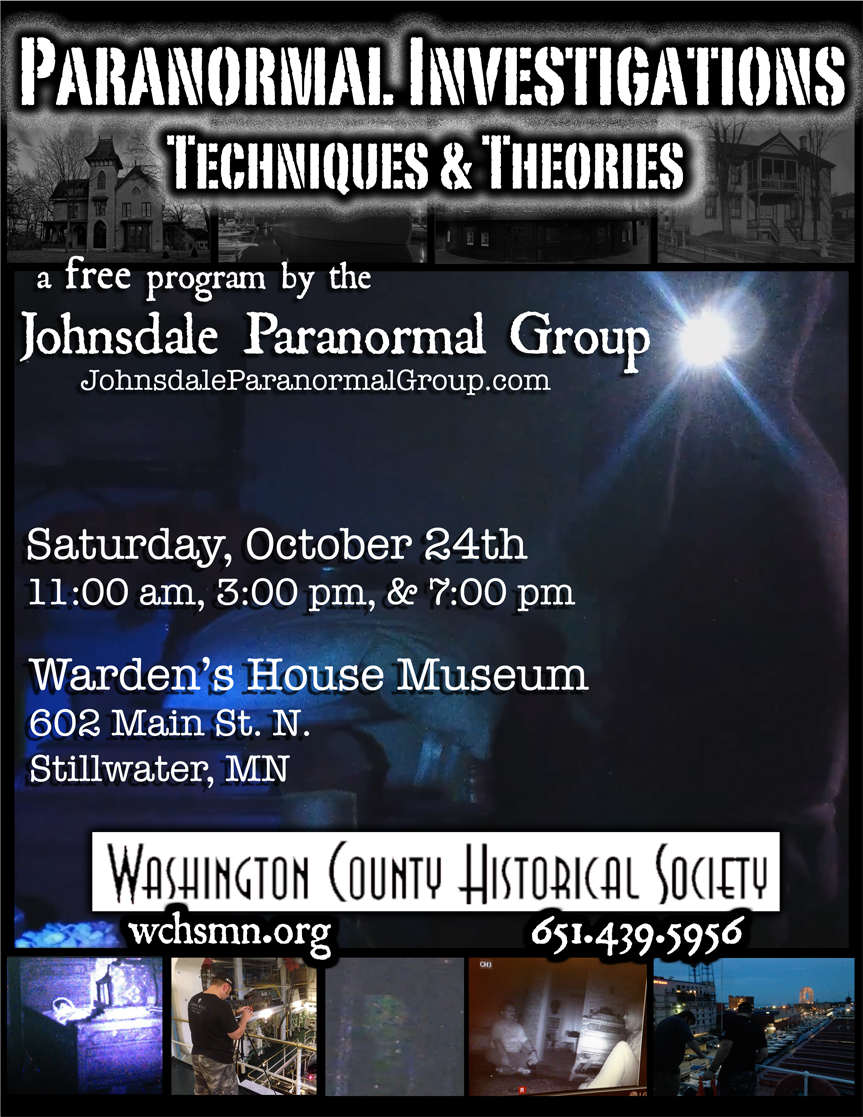 And don’t forget that at the end of the month on, Saturday, October 24th, the Johnsdale Paranormal Group will host their third annual Paranormal Investigations: Techniques & Theories program at the Warden’s House Museum.
And don’t forget that at the end of the month on, Saturday, October 24th, the Johnsdale Paranormal Group will host their third annual Paranormal Investigations: Techniques & Theories program at the Warden’s House Museum.
The event will be held at the Warden’s House Museum in Stillwater. They will host encore presentations at 11:00AM, 3:00PM, and 7:00PM.
Since last year’s event, the group has investigated reportedly haunted local locales such as the Wilson Place Mansion in Menomonie, WI, the LeDuc Mansion in Hastings, the William A. Irvin in Duluth and, of course, another investigation of the Warden’s House itself.
During this free and open to the public presentation, founder Justin Miner and his co-investigators will delve into the evidence they have gathered over the last year and will also explain exactly what goes into a “ghost hunt”. Including a showcase of their state-of-the-art equipment.
Each time slot will feature the same program and will last about 80 minutes.
Please contact Sean Pallas at spallas.wchs@gmail.com or at 651-439-5956 for more information regarding these events.
What is This Thing?!
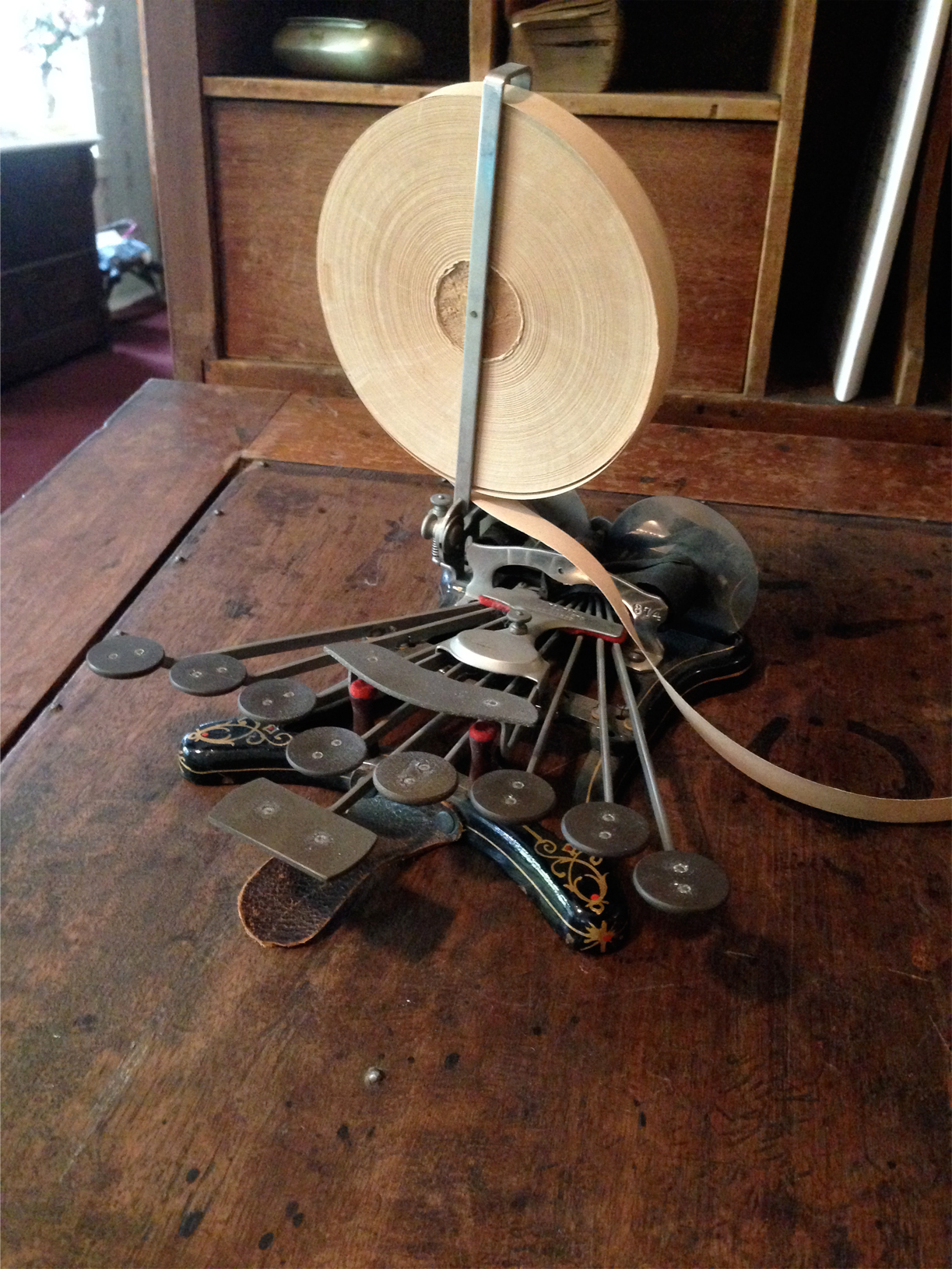
What Is This Thing?! (Round 18)
I’ll admit, last issue’s What Is This Thing?! was pretty obscure!
This large wooden device wasn’t some type of offensive maul, nor was it a hammer used in the lumber industry. It was actually used in the 1890s to make everyone’s favorite Germanic fermented cabbage: Sauerkraut!
This huge wooden masher would have been used when making exceptionally large batches of Sauerkraut.
Thank you to everyone who participated in last week’s challenge! For this week, we’ll get a little bit more technologically advanced…
Can you identify the WCHS artifact photographed above? Can you guess its use? If you’d care to venture an answer, you can send an email to me at spallas.wchs@gmail.com, tweet @WCHSMN, or post your guess on our Facebook page.
Good luck!
Full Image
Old News
A Post Office Heist
In Hollywood, banks are robbed by quirky crews of witty lockpickers, get-away drivers, and safecrackers.
In St. Paul Park, post offices are robbed by guys wielding dynamite, bars of soap, and stolen tools. Slightly less dramatic.
This is an interesting article because as it goes along giving details, it also practically provides instructions on how future robberies may be performed. Maybe this type of reporting was a reason the post office seemed to be a popular locale to “knock off”.
Also, if you remember the Old News in last issue, we discussed a “Simpl Way Of Spellin”. Well apparently the journalist of this article agreed with the idea, at least when it came to the spelling of the word “clue“.
Postoffice Robbed Again – Stillwater Messenger – October 6, 1906
The postoffice at St. Paul Park was entered by burglars early Tuesday morning, the safe was dynamited and the contents were stolen. The cracksmen did not get much, however, as the last remittance had been made on Monday. Chief Inspector Fosness of St. Paul made an investigation, but so far no clew [sic] to the burglars has been found.
The burglars secured a sledgehammer and several chisels from the blacksmith shop of F. H. Bowers and, entering the postoffice by prying up a back window, knocked off the tumbler of the safe and packed the door with soap. The noise of the explosion woke no one. The explosion demolished the safe and one set of postoffice boxes. The tools were found later hidden under the sidewalk in front of the office.
The postoffice at St. Paul Park has been broken into three times within two years, the last burglary having been committed last June. Joseph Trickey is the postmaster.
Featured Article
Burying Stillwater’s Dead
by Brent Peterson, WCHS Executive Director
Stillwater is known as the “Birthplace of Minnesota” and even though Stillwater has given birth to many industries, business, and of course people, there have been many deaths as well. When a person dies in Stillwater there are several cemeteries that our loved ones are buried in. But what happened to those settlers in the early days when there were no cemeteries?
Of course, a burying ground is not necessary unless someone dies.
The first deaths in this area were told about in a interview with Stillwater’s first female resident, Lydia Carli, She said that the, “first death in what is now Stillwater occurred July 14. 1843. The man was named Cole, and his death occurred in what was known as the Tamarack house.. The following night a stranger, an elderly man, whom no one knew, applied for lodgings, and in the morning, which was the 16th, he was found to be exceedingly no more. Nobody knew anything about him, not even his name, and he and the former deceased were buried up in the wilds, half a mile or so farther north. There was no monument erected or other evidence to indicate their burial place.”
As others died in this new lumber town, many were buried in a field owned by John McKusick at the top of the bluff. Eventually this site would overlook the old Minnesota State Prison and is today north of Laurel between Third and Fourth Streets. Another small cemetery was at the top of Myrtle Street where six to eight “old-timers” were buried. This smaller cemetery had to be moved to the “city burial ground” which must have meant to McKusick’s land north of Laurel. The move was made necessary because of the expansion of the city. When these bodies were moved, the March 16, 1858 Stillwater Messenger said that the “coffins were in a state of good preservation, and were decently re-interred. No sorrowing friends, or stricken relative, or imposing funeral cortege attended upon these second rites.”
As for the people themselves, the article says that “we have made some inquiry of those few who were then citizens of this place with reference to the person there interred, and find that most of them were person then employed up on the river, and that but little is known of their early history.”
Five years later, the Messenger make a call to its readers about the poor condition of the cemetery on the North Hill.
The June 2, 1863 article says that “the gates are down so that cattle range at large over the grounds breaking down the shrubbery and tomb stones. A large part of the grounds is growing up to bushes, which, in a few years, if not attended to, will become an impenetrable thicket.” It appears the repairs never materialized, the Messenger made a call for the creation of a Cemetery Association to solve this issue.
This first meeting was held, appropriately, on the evening of October 31st for the purpose of organizing such an Association. A committee was appointed to “select some suitable grounds for a cemetery” and to see at what price this land would be purchased for. The Committee consisted of Isaac Staples, R. Lehmicke and A.B. Stickney. Land was selected for this cemetery on South Fourth Street in Stillwater. The name given to the Cemetery Association was “Fairview.”
By the early 1870s, those buried in the cemetery at the north end of town were being removed and re-buried in the new cemetery. Did those people dig up all the bodies? Not really. When the new Lincoln School was built on the site, several bodies were found. Twenty years ago, another homeowner was digging for a pool when body turned up. A few years later, a couple making a garden in their back yard turned up a head stone with the date of death being 1863.
Be careful where you step in the “Birthplace of Minnesota” – we’ve had a lot of deaths here too.



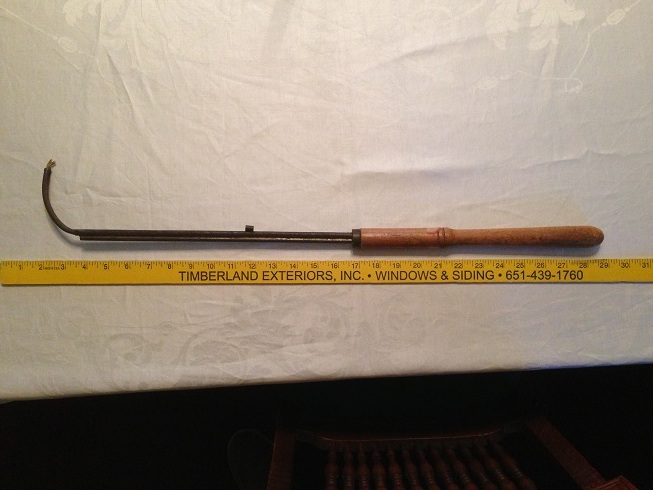
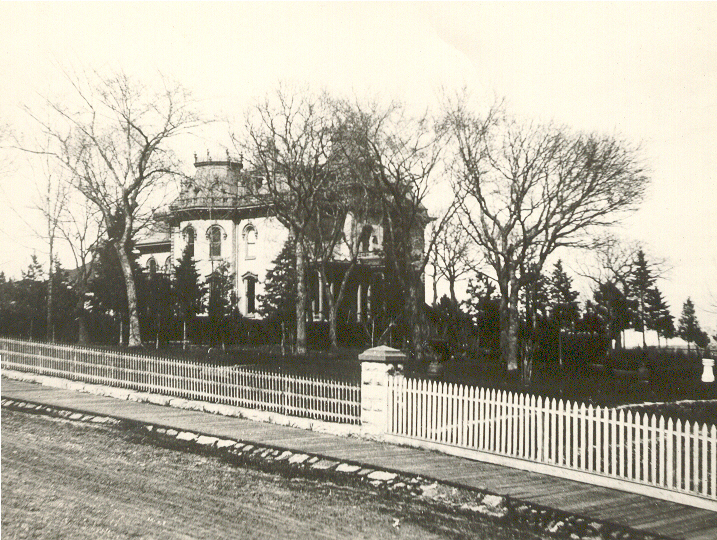 As the lumber industry hit it’s boom in Stillwater, many new millionaire’s began constructing the gorgeous homes that still dot the modern city’s hillside.
As the lumber industry hit it’s boom in Stillwater, many new millionaire’s began constructing the gorgeous homes that still dot the modern city’s hillside.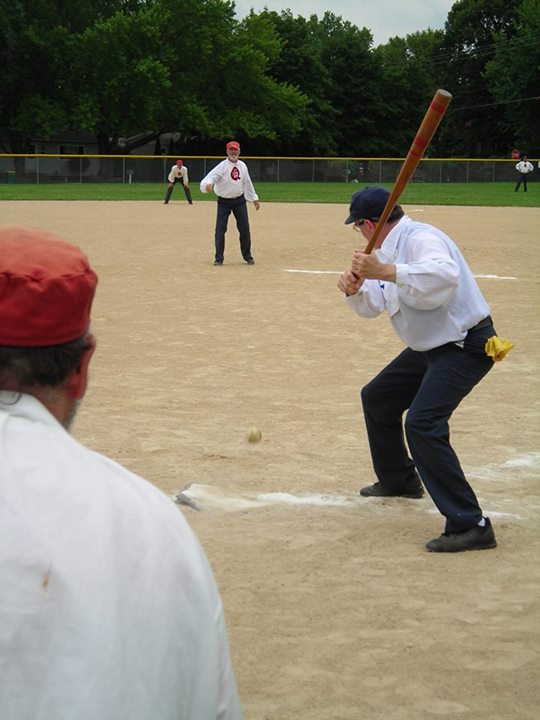 “On the ninth and last inning, the St. Croixs went to bat under favorable circumstances and were evidently determined to run up another good score but their opponents took two pretty flys and one foul, and forced them to go to the field after making two tallies. The Minnehahas now came to bat realizing that nothing but hard work would save the silver ball to them – for they had to make seven tallies to tie and eight to beat their opponents. Vangilder, Fuller and Miner succeeded in making one run each and the game closed leaving the St. Croix boys four tallies ahead on the game.”
“On the ninth and last inning, the St. Croixs went to bat under favorable circumstances and were evidently determined to run up another good score but their opponents took two pretty flys and one foul, and forced them to go to the field after making two tallies. The Minnehahas now came to bat realizing that nothing but hard work would save the silver ball to them – for they had to make seven tallies to tie and eight to beat their opponents. Vangilder, Fuller and Miner succeeded in making one run each and the game closed leaving the St. Croix boys four tallies ahead on the game.”